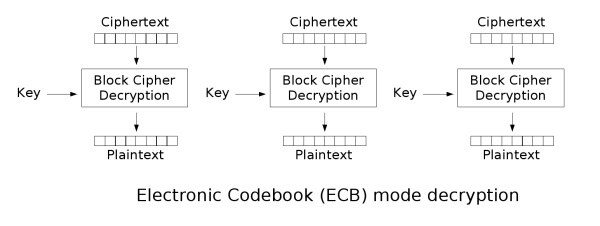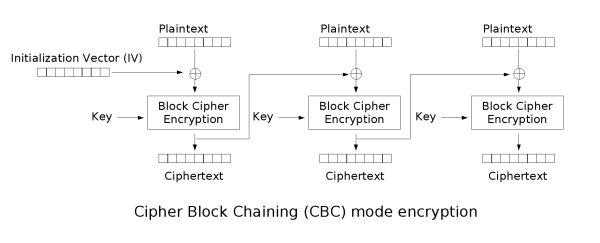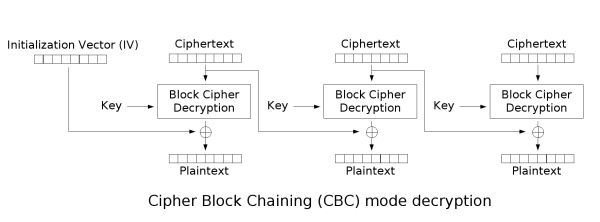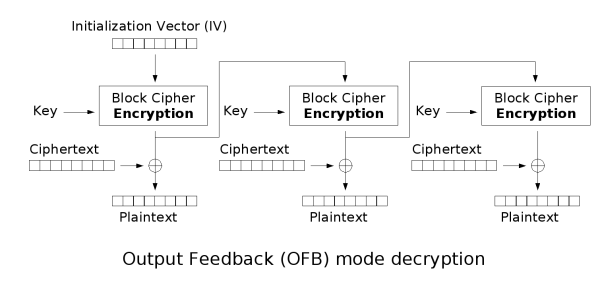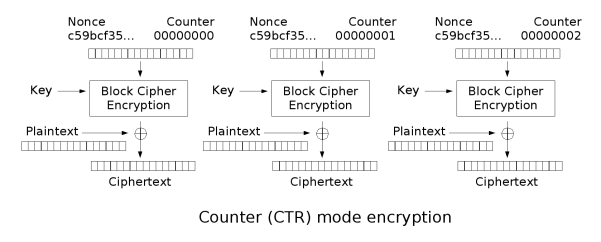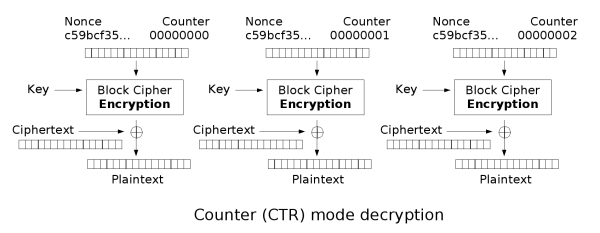Block cipher modes of operation
From Wikipedia, the free encyclopedia
In cryptography, a block cipher operates on blocks of fixed length, often 64 or 128 bits. Because messages may be of any length, and because encrypting the same plaintext under the same key always produces the same output (as described in the ECB section below), several modes of operation have been invented which allow block ciphers to provide confidentiality for messages of arbitrary length.
The earliest modes described in the literature (eg, ECB, CBC, OFB and CFB) provide only confidentiality or message integrity, but do not perform both simultaneously. Other modes have since been designed which ensure both confidentiality and message integrity in one pass, such as IAPM, CCM, EAX, GCM, and OCB modes. Tweakable narrow-block encryption (LRW) mode, and wide-block encryption (CMC and EME) modes, designed to securely encrypt sectors of a disk, are described in the article devoted to disk encryption theory.
[edit] Initialization vector (IV)
All these modes (except ECB) require an initialization vector, or IV -- a sort of 'dummy block' to kick off the process for the first real block, and also to provide some randomization for the process. There is no need for the IV to be secret, in most cases, but it is important that it is never reused with the same key. For CBC and CFB, reusing an IV leaks some information about the first block of plaintext, and about any common prefix shared by the two messages. For OFB and CTR, reusing an IV completely destroys security. In CBC mode, the IV must, in addition, be randomly generated at encryption time.
[edit] Electronic codebook (ECB)
The simplest of the encryption modes is the electronic codebook (ECB) mode. The message is divided into blocks and each block is encrypted separately. The disadvantage of this method is that identical plaintext blocks are encrypted into identical ciphertext blocks; thus, it does not hide data patterns well. In some senses, it doesn't provide serious message confidentiality, and it is not recommended for use in cryptographic protocols at all.
Here's a striking example of the degree to which ECB can leave plaintext data patterns in the ciphertext. A pixel-map version of the image on the left was encrypted with ECB mode to create the center image:
 |
 |
 |
| Original | Encrypted using ECB mode | Encrypted using other modes |
The image on the right is how the image might look encrypted with CBC, CTR or any of the other more secure modes—indistinguishable from random noise. Note that the random appearance of the image on the right tells us very little about whether the image has been securely encrypted; many kinds of insecure encryption have been developed which would produce output just as 'random-looking'.
ECB mode can also make protocols without integrity protection even more susceptible to replay attacks, since each block gets decrypted in exactly the same way. For example, the Phantasy Star Online: Blue Burst online video game uses Blowfish in ECB mode. Before the key exchange system was cracked leading to even easier methods, cheaters repeated encrypted "monster killed" message packets, each an encrypted Blowfish block, to illegitimately gain experience points quickly.
[edit] Cipher-block chaining (CBC)
CBC mode of operation was invented by IBM in 1976. [1] In the cipher-block chaining (CBC) mode, each block of plaintext is XORed with the previous ciphertext block before being encrypted. This way, each ciphertext block is dependent on all plaintext blocks processed up to that point. Also, to make each message unique, an initialization vector must be used in the first block.
If the first block has index 1, the mathematical formula for CBC encryption is
while the mathematical formula for CBC decryption is
CBC has been the most commonly used mode of operation. Its main drawbacks are that encryption is sequential (i.e., it cannot be parallelized), and that the message must be padded to a multiple of the cipher block size. One way to handle this last issue is through the method known as ciphertext stealing.
Note that a one-bit change in a plaintext affects all following ciphertext blocks. A plaintext can be recovered from just two adjacent blocks of ciphertext. As a consequence, decryption can be parallelized, and a one-bit change to the ciphertext causes complete corruption of the corresponding block of plaintext, and inverts the corresponding bit in the following block of plaintext.
[edit] Propagating cipher-block chaining (PCBC)
The propagating cipher-block chaining or plaintext cipher-block chaining[2] mode was designed to cause small changes in the ciphertext to propagate indefinitely when decrypting, as well as when encrypting.
Encryption and decryption algorithms are as follows:
PCBC is used in Kerberos v4 and WASTE, most notably, but otherwise is not common. In fact when, on a message encrypted in PCBC mode, two adjacent blocks are exchanged, this does not affect the subsequent blocks[3] and is thus no longer used in Kerberos v5.
[edit] Cipher feedback (CFB)
The cipher feedback (CFB) mode, a close relative of CBC, makes a block cipher into a self-synchronizing stream cipher. Operation is very similar; in particular, CFB decryption is almost identical to CBC encryption performed in reverse:
This simplest way of using CFB described above is not anymore self-synchronizing than other cipher modes like CBC. If a whole blocksize of ciphertext is lost both CBC and CFB will synchronize, but losing only a single byte or bit will permanently throw off decryption. To be able to synchronize after the loss of only a single byte or bit a single byte or bit must be encrypted at a time. CFB can be used this way when combined with a shift register as the input for the block cipher.
To use CFB to make a self-synchronizing stream cipher that will synchronize for any multiple of x bits lost, start by initializing a shift register the size of the block size with the initialization vector. This is encrypted with the block cipher, and the highest x bits of the result or XOR'ed with x bits of the plaintext to produce x bits of ciphertext. These x bits of output are shifted into the shift register, and the process repeats with the next x bits of plaintext. Decryption is similar, start with the initialization vector, encrypt, and XOR the high bits of the result with x bits of the ciphertext to produce x bits of plaintext. Then shift the x bits of the ciphertext into the shift register.
In notation, where Si is the ith state of the shift register, a << x is a shifted up x bits and head(a, x) is the x highest bits of a:
If x bits are lost from the ciphertext, the cipher will output incorrect plaintext until the shift register once again equals a state it held while encrypting, at which point the cipher has resynchronized. This will result in at most one blocksize of output being garbled.
Like CBC mode, changes in the plaintext propagate forever in the ciphertext, and encryption cannot be parallelized. Also like CBC, decryption can be parallelized. When decrypting, a one-bit change in the ciphertext affects two plaintext blocks: a one-bit change in the corresponding plaintext block, and complete corruption of the following plaintext block. Later plaintext blocks are decrypted normally.
CFB shares two advantages over CBC mode with the stream cipher modes OFB and CTR: the block cipher is only ever used in the encrypting direction, and the message does not need to be padded to a multiple of the cipher block size (though ciphertext stealing can also be used to make padding unnecessary).
[edit] Output feedback (OFB)
The output feedback (OFB) mode makes a block cipher into a synchronous stream cipher: it generates keystream blocks, which are then XORed with the plaintext blocks to get the ciphertext. Just as with other stream ciphers, flipping a bit in the ciphertext produces a flipped bit in the plaintext at the same location. This property allows many error correcting codes to function normally even when applied before encryption.
Because of the symmetry of the XOR operation, encryption and decryption are exactly the same:
Each output feedback block cipher operation depends on all previous ones, and so cannot be performed in parallel. However, because the plaintext or ciphertext is only used for the final XOR, the block cipher operations may be performed in advance, allowing the final step to be performed in parallel once the plaintext or ciphertext is available.
It is possible to obtain an OFB mode keystream by using CBC mode with a constant string of zeroes as input. This can be useful, because it allows the usage of fast hardware implementations of CBC mode for OFB mode encryption.
Using OFB mode with limited feedback like CFB mode reduces the average cycle length by a factor of 232 or more. A mathematical model proposed by Davies and Parkin and substantiated by experimental results showed that only with full feedback an average cycle length near to the obtainable maximum can be achieved. For this reason, support for limited feedback was removed from the specification of OFB. [4] [5]
[edit] Counter (CTR)
- Note: CTR mode (CM) is also known as Integer Counter Mode (ICM) and Segmented Integer Counter (SIC) mode
Like OFB, counter mode turns a block cipher into a stream cipher. It generates the next keystream block by encrypting successive values of a "counter". The counter can be any function which produces a sequence which is guaranteed not to repeat for a long time, although an actual counter is the simplest and most popular. The usage of a simple deterministic input function raised controversial discussions, stating that "deliberately exposing a cryptosystem to a known systematic input represents an unnecessary risk."[6] By now, CTR mode is widely accepted, and problems resulting from the input function are recognized as a weakness of the underlying block cipher instead of the CTR mode. [7] Nevertheless, there are specialised attacks like an Hardware Fault Attack that is based on the usage of a simple counter function as input. [8]
CTR mode has similar characteristics to OFB, but also allows a random access property during decryption. CTR mode is well suited to operation on a multi-processor machine where blocks can be encrypted in parallel.
Note that the nonce in this graph is the same thing as the initialization vector (IV) in the other graphs. The IV/nonce and the counter can be concatenated, added, or XORed together to produce the actual unique counter block for encryption.
[edit] Integrity protection and error propagation
None of the block cipher modes of operation above provide any integrity protection in their operation. This means that an attacker who does not know the key may still be able to modify the data stream in ways useful to them, without any surety those alterations will be detected. It is now generally well understood that wherever data is encrypted, it is nearly always essential to provide integrity protection, as the risks from not doing so are high. For such secure operation, the IV and ciphertext generated by these modes should be authenticated with a secure MAC, which must be checked by the receiver prior to decryption.
Before the message integrity problem was widely recognized, it was common to discuss the "error propagation" properties of a mode of operation as a suitability criterion. It might be observed, for example, that a one-block error in the transmitted ciphertext would result in a one-block error in the reconstructed plaintext for ECB mode encryption, while in CBC mode such an error would affect two blocks:
Some felt that such resilience was desirable in the face of random errors (eg, line noise), while others argued that it increased the scope for attackers to modify messages without assurance of detection if checked.
However, when proper integrity protection is used, such an error will result (with high probability) in the entire message being rejected. If resistance to random error is desirable, error-correcting codes should be applied to the ciphertext before transmission.
Some modes of operation have been designed to combine security and authentication. Examples of such modes are: XCBC[9], IACBC, IAPM[10], OCB, EAX, CWC, CCM, and GCM. These authenticated encryption modes are classified as single pass modes or double pass modes. Some modes also allow for the authentication of unencrypted associated data, and these are called AEAD (Authenticated-Encryption with Associated-Data) schemes. For example, EAX mode is a double pass AEAD scheme while OCB mode is single pass.
[edit] Padding
Because a block cipher works on units of a fixed size, but messages come in a variety of lengths, some modes (mainly CBC) require that the final block be padded before encryption. Several padding schemes exist. The simplest is to add null bytes to the plaintext to bring its length up to a multiple of the block size, but care must be taken that the original length of the plaintext can be recovered; this is so, for example, if the plaintext is a C style string which contains no null bytes except at the end. Slightly more complex is the original DES method, which is to add a single one bit, followed by enough zero bits to fill out the block; if the message ends on a block boundary, a whole padding block will be added. Most sophisticated are CBC-specific schemes such as ciphertext stealing or residual block termination, which do not cause any extra ciphertext; these schemes are relatively complex. Schneier and Ferguson suggest two possibilities, both simple: append a byte with value 128 (hex 80), followed by as many zero bytes as needed to fill the last block, or pad the last block with n bytes all with value n.
CFB, OFB and CTR modes do not require any special measures to handle messages whose lengths are not multiples of the block size, since they all work by XORing the plaintext with the output of the block cipher. The last partial block of plaintext is XORed with the first few bytes of the last keystream block, producing a final ciphertext block that is the same size as the final partial plaintext block. This characteristic of stream ciphers makes them suitable for applications that require the encrypted ciphertext data to be the same size as the original plaintext data, and for applications that transmit data in streaming form where it is inconvenient to add padding bytes.
[edit] Other modes and other cryptographic primitives
Many more modes of operation for block ciphers have been suggested. Some of them have been accepted, fully described (even standardised), and are in use. Others have been found insecure, and should never be used. NIST maintains a list of proposed modes for AES at [1]
Disk encryption often uses special modes. Tweakable narrow-block encryption modes (LRW, XEX, and XTS) and wide-block encryption (CMC and EME) modes are designed to securely encrypt sectors of a disk. (See disk encryption theory)
Block ciphers can also be used in other cryptographic protocols. They are generally used in modes of operation similar to the block modes described here. As with all protocols, to be cryptographically secure, care must be taken to build them correctly.
There are several schemes which use a block cipher to build a cryptographic hash function. See one-way compression function for descriptions of several such methods.
Cryptographically secure pseudorandom number generators (CSPRNGs) can also be built using block ciphers.
Message authentication codes (MACs) are often built from block ciphers. CBC-MAC, OMAC and PMAC are examples.
Authenticated encryption also uses block ciphers as components. It means to both encrypt and MAC at the same time. That is to both provide confidentiality and authentication. IAPM, CCM, EAX, GCM and OCB are such authenticated encryption modes.
[edit] See also
[edit] References
- ^ William F. Ehrsam, Carl H. W. Meyer, John L. Smith, Walter L. Tuchman, "Message verification and transmission error detection by block chaining", US Patent 4074066, 1976
- ^ Kaufman, C., Perlman, R., & Speciner, M (2002). Network Security. Upper Saddle River, NJ: Prentice Hall. Page 319 (2nd Ed.)
- ^ Kohl, J. "The Use of Encryption in Kerberos for Network Authentication", Proceedings, Crypto '89, 1989; published by Springer-Verlag
- ^ D. W. Davies and G. I. P. Parkin. The average cycle size of the key stream in output feedback encipherment. In Advances in Cryptology, Proceedings of CRYPTO 82, pages 263–282, 1982
- ^ http://www.crypto.rub.de/its_seminar_ws0809.html
- ^ Robert R. Jueneman. Analysis of certain aspects of output feedback mode. In Advances in Cryptology, Proceedings of CRYPTO 82, pages 99–127, 1982.
- ^ Helger Lipmaa, Phillip Rogaway, and David Wagner. Comments to NIST concerning AES modes of operation: CTR-mode encryption. 2000
- ^ R. Tirtea and G. Deconinck. Specifications overview for counter mode of operation. security aspects in case of faults. In Electrotechnical Conference, 2004. MELECON 2004. Proceedings of the 12th IEEE Mediterranean, pages 769–773 Vol.2, 2004.
- ^ Virgil D. Gligor, Pompiliu Donescu, "Fast Encryption and Authentication: XCBC Encryption and XECB Authentication Modes". Proc. Fast Software Encryption, 2001: 92-108.
- ^ Charanjit S. Jutla, "Encryption Modes with Almost Free Message Integrity", Proc. Eurocrypt 2001, LNCS 2045, May 2001.


